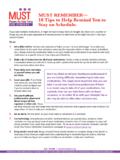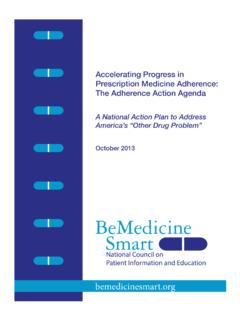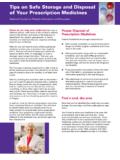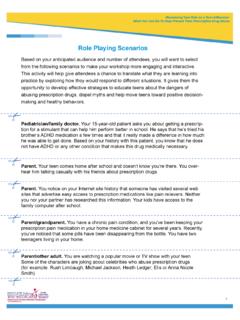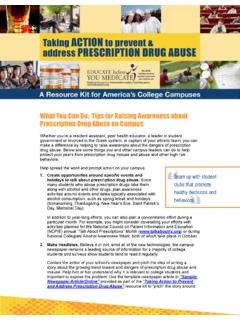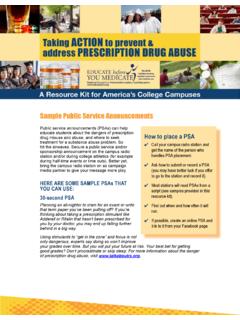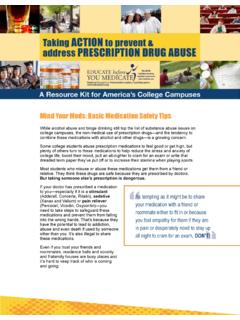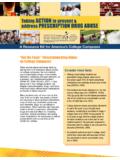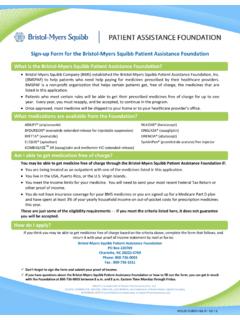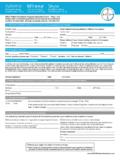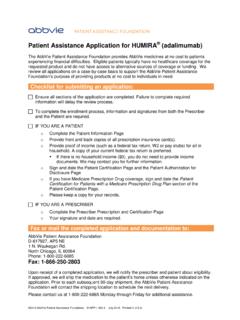Transcription of Understanding Prescription Assistance Programs (PAPs)
1 1 Understanding Prescription Assistance Programs (PAPs) The use of Prescription medicines has become an increasingly important part of quality medical care. Two out of every three visits to the doctor end with a Prescription being written. Nearly billion prescriptions were filled in the in 2005. Prescribed medications range from drugs to clear an ear or sinus infection to those used to treat or manage debilitating, potentially life-threatening conditions, such as diabetes, asthma, heart disease and cancer. Access to these drugs can mean improved patient outcomes and quality of life, and can help prevent or delay more costly medical problems.
2 Yet, the number of Americans who cannot afford to pay for needed Prescription medications is on the rise. This trend poses a serious threat to individual and public health. Consider the following: More than 46 million Americans do not have health insurance and millions more are underinsured; eight out of 10 uninsured people are from working families Among those with health insurance, one out of 10 individuals 65 years old or younger and one in three persons over age 65 of age do not have Prescription drug coverage Not surprisingly, people with low incomes, older adults and those suffering with chronic conditions that require multiple medications face the greatest economic burden.
3 These patients also tend to take less of their medication than has been prescribed due to cost concerns. In fact, uninsured adults and their families are twice as likely as insured adults to underuse their medications in order to lower drug costs. Another recent survey of American adults found that in the past year: One in five adults had not filled at least one Prescription One in seven (14%) admitted taking a smaller dose than prescribed Slightly more (16%) said they had taken a medicine less frequently than prescribed The decision to skip or take lower doses of prescribed medicines can quickly lead to serious health complications, increased visits to the emergency department and hospitalizations, especially among patients with chronic medical conditions ( , asthma, heart failure, depression).
4 What are PAPs? Prescription Assistance Programs , or PAPs, have emerged in an effort to help patients who lack health insurance or Prescription drug coverage obtain the medications they need. These Programs are typically offered by pharmaceutical companies to provide free or low cost Prescription drugs to qualifying individuals. By providing financial Assistance for hundreds of medications, PAPs provide a valuable resource to patients , helping them comply with recommended drug regimens and, in turn, obtain better health outcomes. 2 Millions of Americans use PAPs to get the medicines they need but can t afford. PAPs are also called patient Assistance Programs or medication Assistance Programs .
5 Eligibility and Enrollment Requirements Most pharmaceutical companies voluntarily offer PAPs. It is important for health care providers, patients and caregivers to research and understand the eligibility criteria and application process for specific PAPs as they differ considerably from one program to the next. In general, most Programs require the applicant have: 1) Limited or no Prescription drug coverage from private or public sources; 2) A demonstrated financial need based on set income and asset limitations; and, 3) Proof of residence or citizenship. Steps in the Process Although there is no standard enrollment process, most PAPs require the health care provider, patient, or both to complete an application form.
6 A doctor s signature is almost always required. Some pharmaceutical companies have a single form applicable to all of their medications while others have a separate form for each drug. Most are available online (See list of Resources to get help). The type and depth of information requested also varies. The program application may require information about the patient s: Diagnosis and medical need which would need to be documented by the treating physician, nurse, or patient advocate; Health and drug insurance coverage to show that the patient does not have Prescription drug coverage and/or does not qualify for private or public health insurance (such as Medicare or Medicaid).
7 In many cases, patients who have health insurance but do not have Prescription coverage are eligible for PAPs. Eligibility to participate in a PAP varies for patients with Medicare, but these must operate outside the Part D benefit. Some Programs will assist Medicare beneficiaries who don't have supplemental drug coverage, while others will deny Assistance to those patients who are eligible for drug benefits from any public Assistance program (including state and local Programs ), regardless of whether they are enrolled. Individual or household income documented by W-2 forms, income tax returns and/or bank statements. In most cases, a person s income needs to fall below 200% of the Federal Poverty Level (FPL).
8 3200% FPL for 2006 Family Size Gross Annual Income 1 $19,600 2 $26,400 3 $33,200 4 $40,000 Source: Department of Health and Human Services If approved, the patient s Prescription is generally sent to the provider s office or a local pharmacy for distribution. The patient typically receives a 30- to 180-day supply. Many PAPs require the patient to submit a new application in order to receive a refill of their Prescription . Other Discount Programs to Help Cut Costs Together Rx Access is one of the newest Prescription savings Programs for eligible individuals and families.
9 The Together Rx Access Card was created by 10 pharmaceutical companies to help patients gain access to needed medicines. The card is accepted at most pharmacies and gives patients savings at the pharmacy counter. To quality, applicants must lack Prescription drug coverage, be ineligible for Medicare, have a household income of less than $30,000 for a single person or $60,000 for a family of four and be legal residents of the or Puerto Rico. Qualifying card holders save 25-40% on more than 300 brand-name Prescription products. The card also applies to certain generic drugs. Together Rx Access also directs patients to the Partnership for Prescription Assistance , a clearinghouse for more than 475 public and private Assistance Programs , including 180 offered by pharmaceutical companies.
10 Together Rx Access, the Partnership for Prescription Assistance and other organizations have launched grassroots efforts to help raise awareness of Prescription Assistance Programs and make enrollment for discount drug card Programs as easy as possible. State and county Prescription Assistance Programs are on the rise. Similar to the Programs sponsored by pharmaceutical manufacturers, coverage and qualifications vary. In 2005, the National Association of Counties (NACo) in partnership with Caremark, Inc., unveiled a Prescription discount card to help consumers regardless of age, income level or health condition save on drug costs. The free cards are distributed in the sponsoring county and may be used at any participating retail pharmacy.
